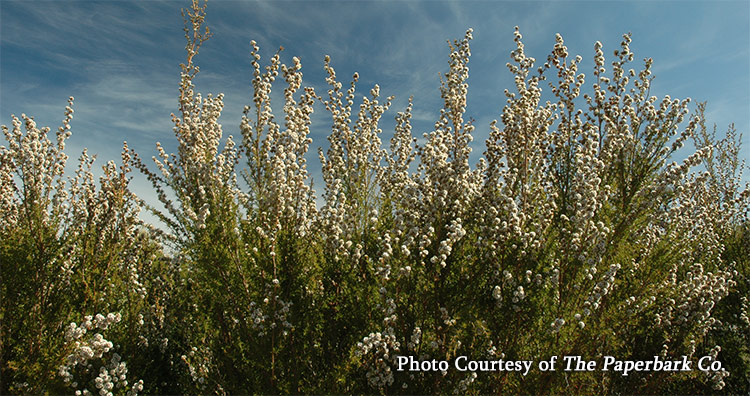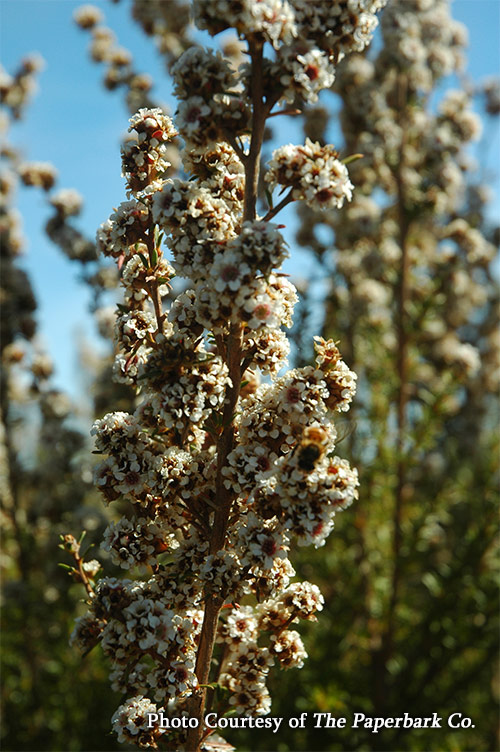Fragonia Essential Oil
Taxandria fragrans / Agonis fragrans

Description
Fragonia Essential Oil is a beautiful Australian oil that offers physical, emotional and energetic benefits. It shares some aromatic characteristics to that of Eucalyptus Essential Oil due to its composition of 1,8-Cineole. Fragonia Essential Oil, however, also possesses underlying citrus, floral and woody notes.
Therapeutically, Fragonia Essential Oil shines as a respiratory oil. It is also highly anti-microbial. It has also been utilized as an anti-inflammatory oil. Fragonia Essential Oil is comprised of approximately 28-32% Cineole, 30-35% Monoterpenes including 20-28% a-Pinene and 22-30% Monoterpenols including 6-11% Linalol.

For emotional applications, Robbi Zeck, ND, writes that Fragonia Essential Oil can help enhance dignity and reduce fragility. She says "Fragonia carries a unique energy pattern bringing the gift of the power of love... Fragonia gently helps to remove scars from the emotional framework, alleviating toxic residue and mental static..." [Robbi Zeck, ND, The Blossoming Heart: Aromatherapy for Healing and Transformation (Victoria, Australia: Aroma Tours, 2008), 80-81.]
The common name Fragonia (TM) is a trademark of the Paperbark Co.
According to The Paperbark Co.'s Web Site and from my general understanding of the situation, the Paperbark Co. grows, harvests and distills a specific chemotype of Agonis fragrans (also known as Taxandria fragrans) that is considered superior to Agonis fragrans that may be harvested and distilled from other sources. The Paperbark Co. trademarked the common name of Fragonia to ensure that only Agonis fragrans originally sourced from them can utilize Fragonia as the common name. All oil named Fragonia, if procured from a reputable source, originates from The Paperbark Co.
Both the botanical names of Agonis fragrans and Taxandria fragrans are used to denote Fragonia Essential Oil.

Fragonia Essential Oil Benefits and Uses
- Respiratory Conditions
- Bronchitis
- Catarrh
- Sinus Congestion
- Colds
- Bacterial And Fungal Infections
- Pain
- Acne
- Inflammatory Muscular Conditions
Source: Valerie Ann Worwood, The Complete Book of Essential Oils and Aromatherapy (Novato, CA: New World Library, 2016), 588-589.
Botanical Name
Taxandria fragrans or Agonis fragrans
Plant Family
Common Method of Extraction
Steam Distilled
Plant Part Typically Used
Color
Clear to Pale Yellow
Consistency
Thin
Perfumery Note
Top
Strength of Initial Aroma
Medium
Aromatic Description
Fragonia Essential Oil smells fresh, with cineolic (eucalyptus-like), citrus, floral and woody characteristics.
- To Calm
- To Promote Sleep
Source: D. Penoel, The Latest Promising Aromatic Gift from Australia. Aromatherapy Today, 2006; 12-18. Source Cited in Salvatore Battaglia, The Complete Guide to Aromatherapy Third Edition Volume 1 - Foundations & Materia Medica (Brisbane Australia: Black Pepper Creative, 2018), 304.
Major Constituents
- 1,8-Cineole
- a-Pinene
- Linalol
- a-Terpineol
- Terpinen-4-ol
See Essential Oil Safety for a more complete list of typical constituents.
Source: Private Communication: Day, 2004. Source cited in Robert Tisserand and Rodney Young, Essential Oil Safety (Second Edition. United Kingdom: Churchill Livingstone Elsevier, 2014), 286.
Fragonia Essential Oil Safety Information
Tisserand and Young warn that due to its a-Pinine content (approximately 20-28%), old and oxidized Fragonia should not be used and that careful storage, preferably in the refrigerator is recommended. Reading Tisserand and Young's full profile is recommended. [Robert Tisserand and Rodney Young, Essential Oil Safety (Second Edition. United Kingdom: Churchill Livingstone Elsevier, 2014), 286-287.]
General Safety Information
Do not take any oils internally and do not apply undiluted essential oils, absolutes, CO2s or other concentrated essences onto the skin without advanced essential oil knowledge or consultation from a qualified aromatherapy practitioner. For general dilution information, read AromaWeb's Guide to Diluting Essential Oils. If you are pregnant, epileptic, have liver damage, have cancer, or have any other medical problem, use oils only under the proper guidance of a qualified aromatherapy practitioner. Use extreme caution when using oils with children and be sure to first read the recommended dilution ratios for children. Consult a qualified aromatherapy practitioner before using oils with children, the elderly, if you have medical issues or are taking medications. Before using this or any essential oil, carefully read AromaWeb's Essential Oil Safety Information page. For in-depth information on oil safety issues, read Essential Oil Safety by Robert Tisserand and Rodney Young.
Shelf Life
Important Information About the Profiles
The essential oil information provided on AromaWeb is intended for basic educational purposes only. The references to safety information, test results, constituents and percentages is generalized information. Essential oils can vary greatly in composition. The data is not necessary complete and is not guaranteed to be accurate. The essential oil photos are intended to represent the typical and approximate color of each essential oil. However, essential oil composition and color can vary based on harvesting, distillation, age of the essential oil and other factors. Profiles for several CO2 Extracts and absolutes are included within the directory, and are denoted as such.
